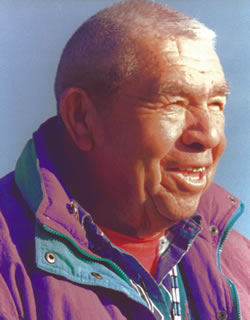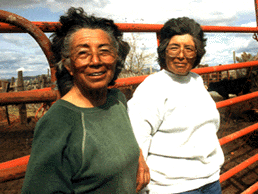Corbin Harney facts for kids
Quick facts for kids
Corbin Harney
|
|
|---|---|
 |
|
| Born | March 24, 1920 |
| Died | July 10, 2007 (aged 87) near Petaluma, California
|
| Nationality | Western Shoshone |
| Known for | activist for environmental justice |
Corbin Harney (March 24, 1920 – July 10, 2007) was an important elder and spiritual leader of the Newe, or Western Shoshone, people. He was a strong voice for protecting the Earth. Harney helped start the Shundahai Network in 1994. This group works for environmental justice, which means fair treatment for everyone regarding the environment. They also work for nuclear disarmament, which means getting rid of nuclear weapons. The Shundahai Network helps organize peaceful protests to close the Nevada Test Site. This site, used for testing nuclear weapons, is on Western Shoshone land.
Contents
Early Life and Teachings
Corbin Harney's school days ended when he was nine years old. He left Indian boarding school because he felt his classmates were not treated well. From 1957, he worked with medicine women in Battle Mountain, Nevada. He helped lead important ceremonies like the Sundance Ceremony and sweat lodges. He also helped people who were sick.
As a medicine person, Harney worked hard to protect the sacred places and burial grounds of his people. He was taught from a young age that all life is sacred and should be respected.
Protecting the Land and People
Harney spent his life trying to save the land where his people had lived for thousands of years. The United States Government has exploded over 1,000 nuclear weapons at the Nevada Test Site. This land belongs to the Western Shoshone people, based on the Treaty of Ruby Valley (1863).
Harney traveled around the world to share his message. He warned people about the dangers of nuclear energy and nuclear weapons.

In 1989, Harney visited a former Soviet hydrogen bomb testing site in Semipalatinsk, Kazakhstan. He saw people in hospitals who were sick from radiation. These people lived near the Russian nuclear test site. Harney often spoke about how water can become contaminated. He said: "I didn't really understand what I was told until I went to Kazakhstan in Russia. Kazakhstan is where Russia tested hydrogen bombs for many years. Over there I saw water that looks like clean water, but people can't drink it because it is contaminated with radiation... The nature put all the living things here for us to take care of, not to destroy them."
Shundahai Network and Awards
In 1994, Corbin Harney started the Shundahai Network. The word "shundahai" means "peace and harmony with all creation." He was the head of the board for this group until he passed away. In 2003, he received the International Nuclear Free Future Solutions award. This award honors people who work for a world without nuclear dangers.
Harney's own experiences helped people believe his words. He met "Downwinders" in the Western United States. These were US citizens who lived downwind from atomic bomb tests in Nevada and got sick. In 2001, Harney was a main speaker at the Atomic and Hydrogen Bomb Conference in Nagasaki, Japan. There, he spoke with survivors of nuclear weapons testing and use. These included people from the Marshall Islands and other South Pacific islands, as well as survivors from Hiroshima and Nagasaki.
Poo Ha Bah Healing Center
Corbin Harney also started and led Poo Ha Bah. This was a traditional healing center in Tecopa, California. He explained: "I have established Poo-Ha-Bah for all the people. Poo-Ha-Bah in my language is a very important word--it's talking about Doctor Water. My people have always traveled for many miles to get into different kinds of healing waters."
Harney learned traditional Newe ways of medicine and spirituality from childhood. He noticed that many medicinal plants were disappearing because of toxins from mining. He also saw that many birds and animals that once lived on Newe lands were gone.
Books and Legacy
Before he passed away, Harney finished his second book, "The Nature Way." In this book, he shared the traditional knowledge of his people, the Newe.
Corbin Harney worked with sisters Mary Dann and Carrie Dann to protect Western Shoshone lands. The Dann sisters also fought the government's use of their land, and their case even went to the US Supreme Court.
Corbin Harney died from cancer that had spread to his bones.
Films About Corbin Harney and Western Shoshone
- Broken Treaty at Battle Mountain, (1975): This film shows the Western Shoshone's fight to save their land and traditional pine nut trees.
- Newe Segobia is not for sale. The Struggle for Western Shoshone Land (1993): A documentary about the fight for Western Shoshone land.
- To Protect Mother Earth, (1989): This documentary won awards for its message about protecting the Earth.
- American Outrage (2008): This film tells the story of Mary Dann and Carrie Dann, two Western Shoshone sisters who challenged the US government over land rights.
Books by and About Corbin Harney
- Harney, Corbin. The Nature Way (2009). This book shares the traditional knowledge of the Newe people.
- Harney, Corbin. The way it is: one water-one air-one mother earth (1995). This book shares Harney's views on protecting the environment.
- Fradkin, Philip. Fallout an American Nuclear Tragedy (1989). This book discusses the impact of nuclear testing.


